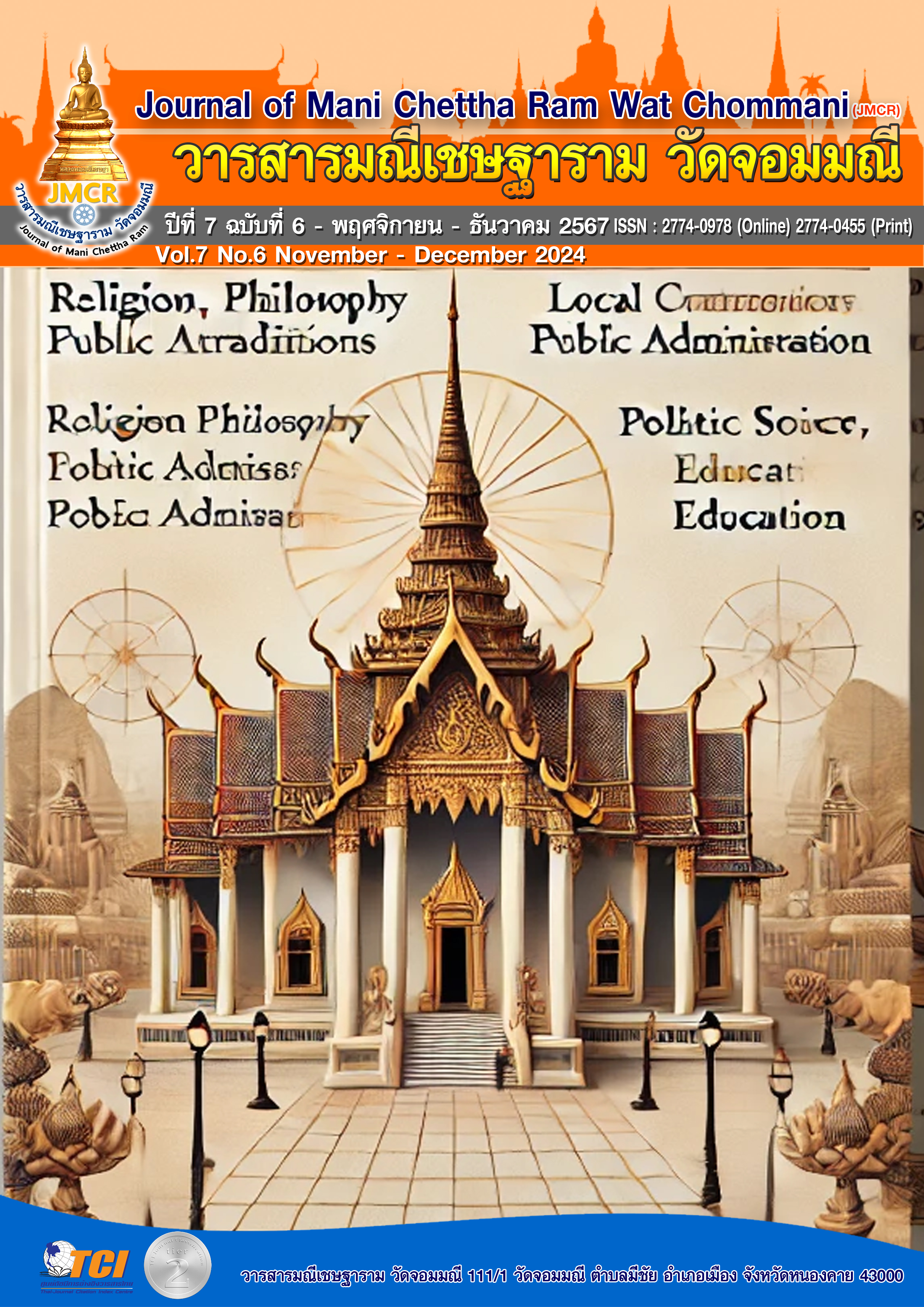STRUCTURAL EQUATION MODEL OF TRANSFORMATIONAL LEADERSHIP OF SCHOOL ADMINISTRATORS UNDER THE SECONDARY EDUCATIONAL SERVICE AREA OFFICE
Keywords:
Transformational Leadership, School Administrators Under the Secondary Educational Service Area Office, Structural Equation Model (SEM)Abstract
The objectives of this research were to: 1) Study and compare the level of transformational leadership among school administrators; 2) Study and compare the influence of factors affecting transformational leadership among school administrators; 3) Examine the consistency of the structural equation model of transformational leadership with empirical data; and 4) Assess the direct, indirect, and total influences of causal factors on transformational leadership. The sample consisted of 984 school administrators under the Secondary Educational Service Area Office, selected through multi-stage random sampling. The research instrument was a closed-ended questionnaire. Data were analyzed using descriptive statistics and inferential statistics, including Chi-Square test, F-test, t-test, and Structural Equation Modeling (SEM).
The research findings revealed that:
1) the overall average level of transformational leadership among school administrators was high. Considering each aspect, it was found that the element of inspiration had the highest mean of (4.67), followed by the idealized influence (4.64), intellectual stimulation (4.61), and individualized consideration (4.59), respectively.
2) the analysis results of school administrators based on different genders, ages, school sizes, and experiences as administrators. There was no significant difference in the level of transformational leadership and causal factors of transformational leadership.
3) the structural equation model was consistent with the empirical data. (P-value = 0.07, = 1.86, GFI = 1.00, AGFI = 0.97, CFI = 1.00, SRMR = 0.00 and RMSEA = 0.02)
4) The total influence of participative management factors on transformational leadership was highest, with a total influence of (0.58), a statistical significance was (.01), the direct influence of (0.23), a statistical significance was (.01) and the indirect influence of (0.34), a statistical significance was (.01), followed by instructional leadership factors, with a total influence of (0.53), a statistical significance was (.01), the direct influence of (0.48), a statistical significance was (.05) and the indirect influence of (0.04), with no statistical significance, and vision setting factors, with a total influence of (0.24), a statistical significance was (.01). The proportion of reliability in transformational leadership variables explained by participative management factors. The instructional leadership and vision setting a percentage of 89.
References
กัลยา วานิชย์บัญชา. 2552. การวิเคราะห์สถิติ : สถิติเพื่อการตัดสินใจ. (พิมพ์ครั้งที่ 4).กรุงเทพมหานคร: โรงพิมพ์แห่งจุฬาลงกรณ์มหาวิทยาลัย.
กริช แรงสูงเนิน. (2554). การวิเคราะปัจจัยด้วย SPSS และ AMOS เพื่อการวิจัย. กรุงเทพมหานคร: ซีเอ็ดยูเคชั่น.
ธนาภรณ์ ชานันโท. (2557). การศึกษาความสัมพันธ์ระหว่างภาวะผู้นำการเปลี่ยนแปลงกับการบริหารงานวิชาการของผู้บริหารสถานศึกษาขั้นพื้นฐาน สังกัดสำนักงานเขตพื้นที่การศึกษามัธยมศึกษา ขต 21. ใน วิทยานิพนธ์ ค.ม. มหาสารคาม: มาหวิทยาลัยราชภัฏมหาสารคาม.
นงลักษณ์ วิรัชชัย. (2549). โมเดลลิสเรล : สถิติวิเคราะห์สําหรับการวิจัย. (พิมพ์ครังที่ 3).กรุงเทพมหานคร: จุฬาลงกรณ์มหาวิทยาลัย.
เพ็ญพร ทองคำสุก. (2553). ตัวแบบสมการโครงสร้างภาวะผู้นำการเปลี่ยนแปลงของผู้บริหารสถานศึกษาขั้นพื้นฐาน. ปรัชญาดุษฎีบัณฑิต สาขาวิชาการบริหารการศึกษา. มหาวิทยาลัยขอนแกน.
ลำดวน เอี่ยมอาจ. (2558). ภาวะผู้นำการเปลี่ยนแปลงของผู้บริหารสถานศึกษาในจังหวัดกำแพงเพชร สังกัดสำนักงานเขตพื้นที่การศึกษามัธยมศึกษา เขต 41. ใน การค้นคว้าอิสระค.ม. มหาวิทยาลัยราชภัฏนครสวรรค์.
ศศิธร รักษาชนม์. (2557). ปัจจัยที่ส่งผลต่อภาวะผู้นำการเปลี่ยนแปลงของผู้บริหารสถานศึกษา สังกัดสำนักงานเขตพื้นที่การศึกษามัธยมศึกษา เขต 30. ใน วิทยานิพนธ์. กศ.ม. มหาสารคาม:มหาวิทยาลัยมหาสารคาม.
สุพรรณิกา สุบรรณาจ. (2560). ปัจจัยที่ส่งผลต่อภาวะผู้นำการเปลี่ยนแปลงของผู้บริหารสถานศึกษา สังกัดสำนักงานเขตพื้นที่การศึกษาประถมศึกษาสุรินทร์ เขต 3. วิทยานิพนธ์ ค.ม. มหาวิทยาลัยราชภัฏบุรีรัมย์.
สำนักบริหารการมัธยมศึกษา สพฐ. (2567). ระบบสารสนเทศด้านคุณภาพมัธยมศึกษา.สำนักงานคณะกรรมการการศึกษาขั้นพื้นฐาน.
สำนักงานปลัดกระทรวงศึกษาธิการ สำนักนโยบายและยุทธศาสตร์. (2561). แผนปฏิบัติราชการประจำปีงบประมาณ พ.ศ. 2561 ของสำนักงานปลัดกระทรวงศึกษาธิการ (ฉบับปรับปรุงตามงบประมาณที่ได้รับจัดสรร). กรุงเทพมหานคร.
สำนักงานคณะกรรมการพัฒนาการเศรษฐกิจและสังคมแห่งชาติ. (2566). แผนพัฒนาเศรษฐกิจและสังคมแห่งชาติ ฉบับที่ 13 (พ.ศ.2566 - 2570). กรุงเทพฯ.
สำนักงานเลขาธิการสภาการศึกษา. (2560). แผนการศึกษาชาติ พ.ศ.2560-2579.กรุงเทพมหานคร: พริกหวานกราฟิค.
เสนาะ กลิ่นงาน. (2551). รูปแบบใหม่ของผู้นำในอนาคต : Leadership for the Future Management Science Journal, 1(1),7-13
Kouzes, J. M. & Posner, B. Z. (1993). The leadership challenge : How to get extraordinary things done in organizations. San Francisco: Jossey - Bass.
McEwan, E.K. (2003). 7 steps to effective instructional leadership. California: Corwin Press.
Yukl, G.A. (2010). Leadership in Organization. 7th Ed. NewJersey: Prentice - Hall.
Hersey, P. and Blanchard, H. B. (1988). Management of Organizational Behavior: Utilizing Human Resources. Englewood. Boston: PWS-Kent.


